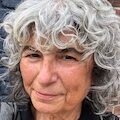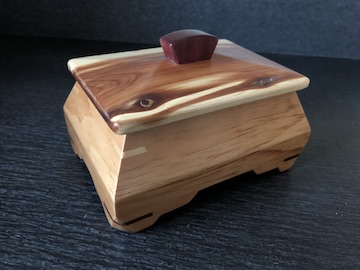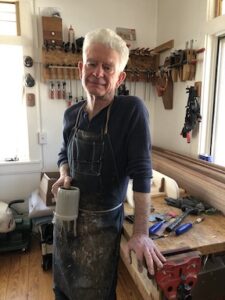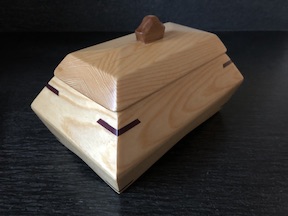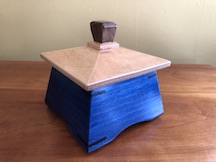Being the humble person he is, Hank wouldn’t call himself an artist. So I will. And his medium of choice is wood.
For so many years, my huband used wood while working on other people’s homes and businesses as a finish carpenter. He has done the same for us and our family, plus building furniture including, chairs, stools, dining room tables, frames, and dansus. He built the desk on which I am writing this post.
At some point, Hank started making boxes from leftover wood, giving them as gifts to oh-so-many people. Consider yourself fortunate if you have one. I’ve managed to hold onto a few I won’t let him give away.
And now the boxes he creates are on display in a gallery in our village. He calls them art boxes, and I believe that is an apt description.
Hank call me in to his shop to show me what he’s working on, explaining how he cut the wood and glued the pieces together in a process called book match to create a grain with interesting patterns. I will see a box in its many stages, including the shaping and carving that give it character. No two boxes are ever alike.
Hank uses a variety of local, exotic, and recycled wood such as chestnut, fir, and cedar. Here’s what went into White Cedar Box No. 1 — Laminated white cedar lid, mortised cherry handle, purple heart bottom, sapele and purple heart feathers. This box has a Zuni influence.
Lids, handles, and knobs are hand-shaped as well as some boxes, employing joinery, aniline dyes, and a variety of finishes.
Hank’s a bit of a perfectionist, but then you have to be to build cabinetry and stairs properly. But he is also inspired by the beauty and serenity in the imperfection of simple things like wood — wabi-sabi. Other inspirations are the Indigenous pottery of Taos, New Mexico, where he once lived and sold his art boxes and furniture, Japanese pottery and architecture, Art Deco, and Southwestern geometric designs.
Hanks sold boxes through galleries in Taos and Albuquerque, and since a couple of weeks ago, they’ve been for sale at Salmon Falls Gallery in Shelburne Falls, the village in Western Massachusetts where we live. The owner is Josh Simpson, a well-known glass artist.
Last week, the first box sold — the Blue Pagoda Box. Certainly, this acknowledgement of Hank’s talent was a reason to celebrate.
Want to see them for yourself? Here’s the link to four of his boxes on Salmon Falls’ website. Four more are in the works in his studio workshop, including one he calls the Red Pencil Box with mortise and tenon joints, a walnut cover with a hand-carved knob and red aniline dye on the box. It’s a work of art.
ABOUT THE PHOTO ABOVE: That’s the Local Pine Box. It has an incense cedar lid, mortised purple heart handle, white cedar bottom, sapele and pine feathers and clipped corners with mesa step detail. The pine is from Hall Tavern Farm in Charlemont.
